I worked in the yard on Saturday as it was a beautiful spring day, and it is the time of year when I have to start readying the garden for summer vegetables. One of my main tasks each spring is to harvest our compost bins, and get the fresh organic material tilled into our planter. This is a task that most unfamiliar with compost might find gross or smelly, but I wanted to take this journal to explain all about compost and the key players involved in the process-- because if done correctly it is neither gross nor smelly.
A: Aerobic
Aerobic means that air, or more specifically oxygen is present. This is a key component of the process of decomposition if you want your compost to remain stink free. At our home we use two different composting systems. First we have a two chambered tumbler as seen below.
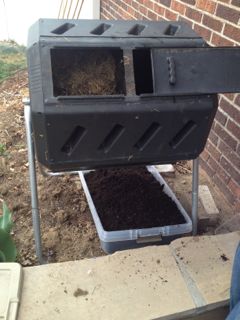 Two chamber compost tumbler, one side for adding new material, and the other waiting as decomposition happens.
Two chamber compost tumbler, one side for adding new material, and the other waiting as decomposition happens.
We collect food scraps and toss them into the chamber marked with the + sign. This way we are only adding scraps to one side at a time and providing time for the side marked with a clock to wait and break down. After adding the scraps we close the container and turn it over. Turning it around and around mixes the new material with the old, as well as introduces air into all of the nooks and crannies. This ensures that all of the microorganisms can continue doing aerobic respiration and thus only release carbon dioxide as a byproduct just like you and I. If oxygen is not present the microorganisms switch to anaerobic respiration and can produce ammonia and hydrogen sulfides (think rotten eggs) as a byproduct and this makes for a very unpleasant odor.
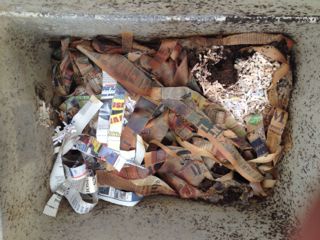 Showing the inside view of the worm bin before digging in to harvest.
Showing the inside view of the worm bin before digging in to harvest.
Our second method is using a worm bin (or vermiculture compost), which is kept in our basement. After collecting and adding food scraps we use a shovel to dig into the organic material and mix in the fresh. We also add shredded paper to help incorporate air spaces as well as help to control the moisture content. I have found after a few years of working both systems that the worm bin has a higher likelihood of developing the unpleasant smell- though if you maintain it and check-in periodically you can easily eliminate the smell if it is starting to develop. The fact that I keep in inside of my home (or occasionally even in my classroom) proves that it can't smell too bad!
B: Biotic
Composting is a biotic (meaning based on living organisms) process, assisted by some abiotic (non-living) factors. The worm bin method stays true to its name and stars the red-wiggler or Eisenia foetida worms. These worms act just like other earthworms you already find in your yard or crawling onto your sidewalk after a rainstorm; however these worms live well in small containers. They can be purchased at most garden centers- particularly in the spring- or ask for some from someone whom already composts. Once you obtain these worms the first time you can keep a self-sustaining population as they will reproduce. You can read more here to discover how to build your own worm bin, and find other information about vermiculture.
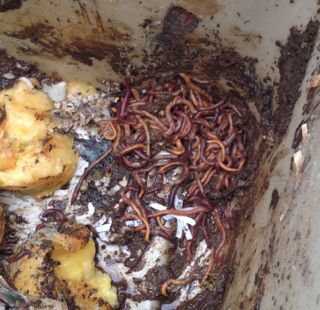 Showing some of the macro-composting red wiggler worms
Showing some of the macro-composting red wiggler worms
There are other small organisms which you may see crawling through your compost, little mites, centipedes, roly polies and beetles, to name a few, are also the critters you could find in most soil ecosystems out in the forest or other ecosystem. These organisms we can see are physical decomposers because they eat the organic material and break it down into smaller pieces after they excrete.
A vital group of organisms in all systems of composting and decomposition, which are not even visible with our naked eyes, are microorganisms. This group is comprised of bacteria and fungus and are considered the chemical decomposers- they change the chemistry of the soil. They are microscopic and are so small you would have to lay 25,000 end to end just to make them cover an inch!
These bacteria excrete nutrients that plants love, such as nitrogen, phosphorus and magnesium. These are the very same types of nutrients that we find in fertilizers or Miracle-Gro that is so often applied to home gardens. This website provides some of the best information I've seen about the particular types of bacteria and other organisms involved, definitely check it out! (http://web.extension.illinois.edu/homecompost/science.cfm)
You can see that the living organisms, and in particular the bacteria are incredibly important in our ecosystems. This summer our expedition will examine freshwater bacteria and I hope to expose you to some of their key roles!
C: Collection
Time to get a little dirty! When I have compost ready for harvest- largely determined via the soil, looking like, well... dirt... and losing all resemblance to the food scraps it started from, it's time to harvest.
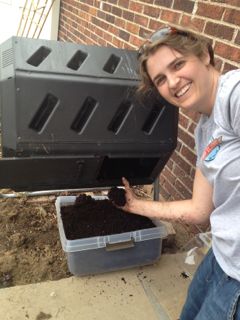 Lauren Watel harvesting the compost tumbler.
Lauren Watel harvesting the compost tumbler.
Harvesting the tumbler involves turning it upside down and dumping it out. There really is no smell, it can be slightly warm to the touch (a higher than air temp environment is created by the bacteria respiring), and the texture is much like potting soil you might buy at the garden center. Easy!
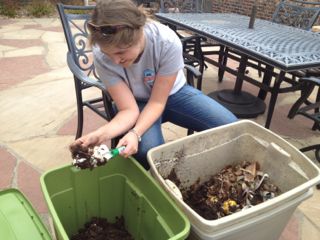 Lauren Watel harvesting the worm bin, removing any straggler worms.
Lauren Watel harvesting the worm bin, removing any straggler worms.
Harvesting the worm bin takes a little more muscle and preparation. Seeing as you want to save your worm community, as I approach the time I want to harvest I use a garden trowel to push all of the mostly digested material to one side of the bin. On the now empty side I place new fresh food scraps, and shredded paper. As a worm, would you rather check out the new food, or stay surrounded in your own waste (or castings)...? So the worms migrate. I usually wait about a month and give the worms time to make their way out of the worm castings. Once they've done this I use my shovel to remove the castings; as I do I pick out any worms I can see and return them to my bin. If I encounter food bits that aren't fully broken down I also return those to the bin to have additional decomposition time.
Any finished compost I am not ready to immediately use is placed in bins and stored in the garage. If I am ready to use them in the garden I take these nutrient dense composts and mix them in with soil. It makes for some of the best fertilizer I've ever used, and makes my garden grow like crazy!
Composting is very easy, and really is a minimal time, monetary and energy investment. It saves a large amount of waste from taking up space in the landfill, and allows you to help your garden or yard with food scraps from your kitchen!
There are many resources about what system is best for your home, and how to avoid problems and fix any sort of issue that may arise. If you are intrigued, feel free ask me or search out local resources in your community to get you started. Many communities (Denver included) even have compost collection, which functions like garbage collection, and take all of the work away from you. I hope you decide to dig into some compost and see what all of these decomposers can help you do!


Comments